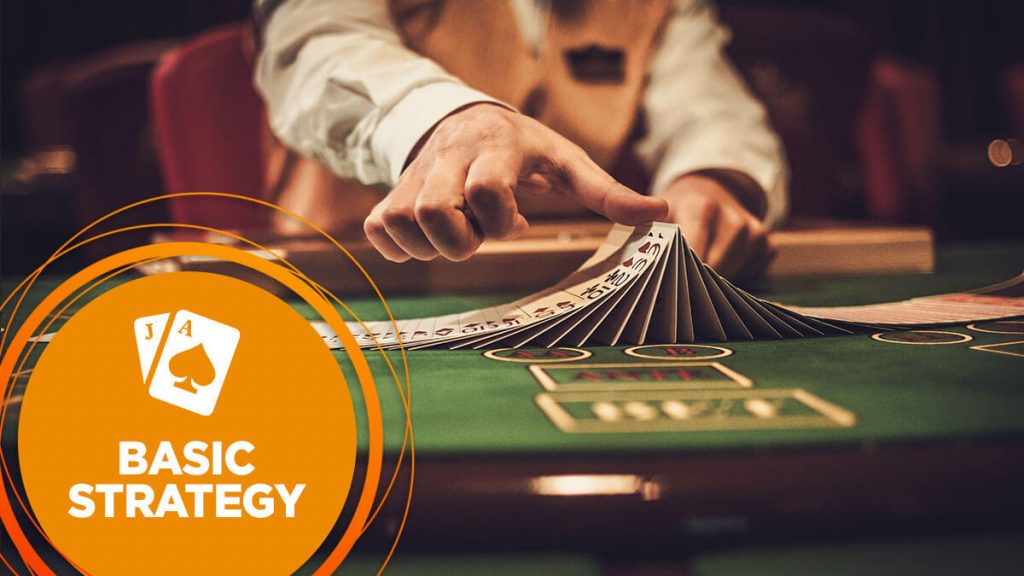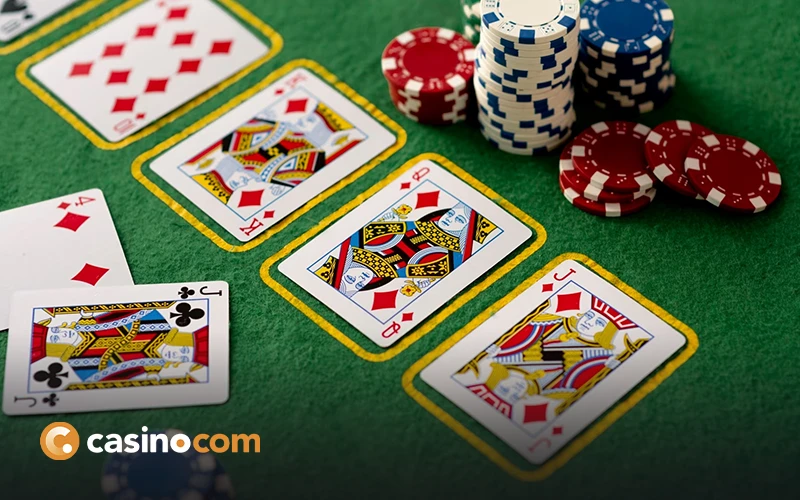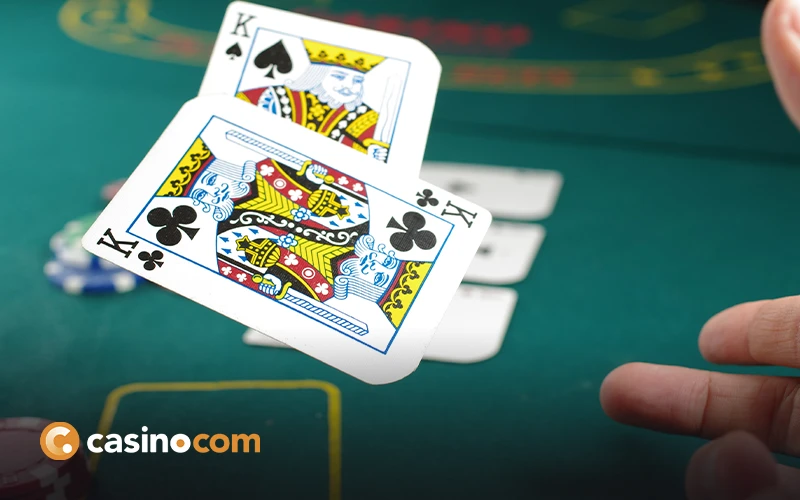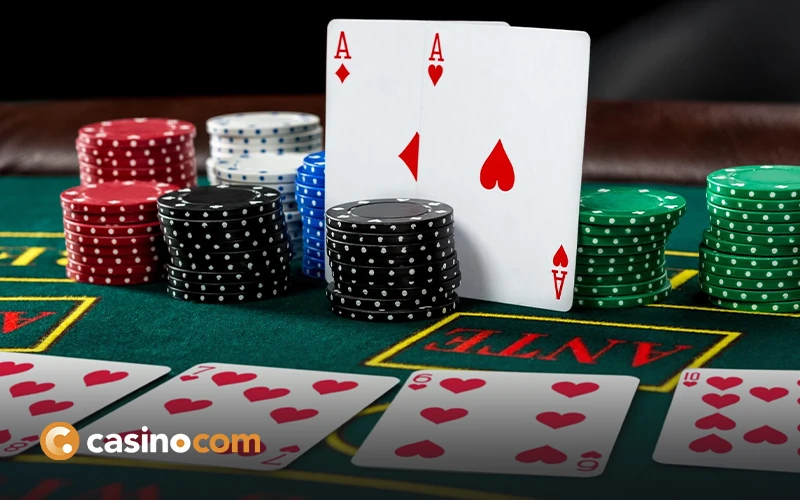In this part of our comprehensive blackjack guides, designed to help you improve your game, we’ve conducted an interview with blackjack expert and industry leader, Michael Shackleford. Here, he provides you with incredible insight into how to get started with the game and how to develop a basic blackjack strategy. Note that Michael does not recommend using betting systems such as Martingale or Andrucci here, simply optimal strategy based on mathematical probabilities.
If you want to know why it’s important to have a basic strategy which will statistically increase your chances of success at the game, read on to find out more.
Here are some of the blackjack strategy questions we will be looking at in this article. Scroll down or click on the links below to jump to a specific section:
- When should you Hit?
- When should you Stand?
- When should you Double Down?
- When should you Split Pairs?
- When should you Surrender?
- When should you Take Insurance?
If you prefer to read on before getting to the nuts and bolts of blackjack play, we will introduce you to Michael Shackleford and also explain the importance of using the correct tactics when you sit down at a (real or virtual) blackjack table.
If you’re interested in blackjack and learning about charts that teach you optimal plays, it’s likely that you may have already come across Shackleford’s well-known site. But where did it all begin for this blackjack aficionado? The computer programmer with a passion for mathematics began analysing casino games as a hobby before starting his own website in 1997. Since then, WizardofOdds.com has gone on to become one of the most trusted sources for gambling advice in the online world.
In recent years, Shackleford has also started to create YouTube videos that explain how to play games with the most effective tactics. Here, we’ve compiled some of Shackleford’s most important points and extensive knowledge, alongside some easy-to-understand charts. Feel free to peruse the whole article, or jump to the section that you need most assistance with. It’s unlikely that you’ll commit this all to memory and so it’s important to remember that you can refer to this guide at any time: you’ll never need to feel stuck in the middle of a blackjack game, ever again.
Why is Strategy Important in Blackjack?
You may be questioning why it’s so crucial to have a strategy for blackjack games in the first place. After all, a lot of it comes down to chance. It is always worth bearing in mind that there are limitations on how much a player can affect a game, although there are certain ways to play which will statistically improve your chances of winning at blackjack. Here are a few of the reasons why Shackleford thinks strategy in blackjack is so important:
- Unlike some casino games, Blackjack allows the player to have an impact on the outcome of the game
- Having a strategy saves money
- Strategies demonstrate a healthy appreciation of maths
- If you are going to play, why not take it seriously and play to the best that you can?
- Strategies are pretty easy to get into
- Players can build on foundational knowledge to improve their skills
- Sticking to a strategy helps players reduce the house edge
While using strategy to play blackjack will never guarantee that you will win, it will statistically improve your chances of success.
How do Players Get Started with Blackjack Basic Strategy?
Shackleford believes that it’s easy for anyone to build up a strong basic knowledge of blackjack which will help players to understand which cards to play in different situations. The first step is to start studying basic strategy charts that show you what the general approach should be in any given situation. These charts display what the dealer’s upcard is and what the players hand is, and all you need to do is find the corresponding square to know what to do. These charts can all be found on Shackleford’s site, and you can also refer to some of the basic ones in this article.
Basic blackjack tips charts can be printed off in the form of a basic strategy card, and it’s perfectly legal to use these for reference during a game. These charts are easy to memorise as well, and Shackleford recommends going for the top half of hard hands first. This way, you’ll already know how to play 80% of hands before moving onto the soft hands and splits.
You need to be aware that there are slightly tweaked strategies for different forms of blackjack. Depending on the strain you are playing and the number of decks, you will need to consult different strategy cards. You should also familiarise yourself with the basic strategy rules at different sites and in varied games. For example, you need to know if the dealer stands on a soft 17, and whether a double or split is allowed. In some games, the dealer is also allowed to peek for a blackjack.
Blackjack Betting Chart: Know What to do in Any Situation
According to research from blackjack expert Peter Griffin on the cost of mistakes, recreational blackjack players give the house an extra edge of 1.4% simply through misplaying. Shackleford believes that players should be fighting for every 0.01% gain they can get, and this can be achieved with even the simplest strategy.
In our detailed interview with the Wizard of Odds, Shackleford laid out the information that everyone needs to know for different circumstances in blackjack. Let’s examine some of the diverse scenarios in more detail. Check out the blackjack chart below for your reference, as well as this will help you visualise the different plays:
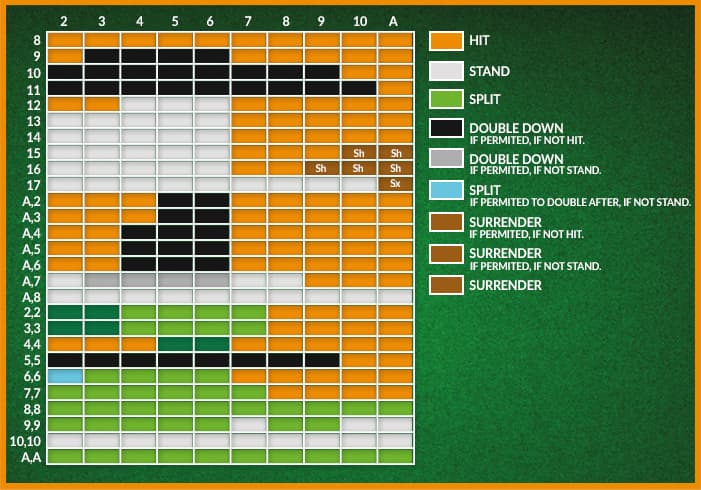
 When Should You Hit?
When Should You Hit?
According to Shackleford: “A player should hit when he has a low total, and the dealer is showing a high up card. So that means the player is saying ‘I’m not happy with what I have now. I’m going to take my chances and take another card.’”
A real-world example of this could be when you’ve been dealt a hand that values a total of 14 and you see that the dealer’s upcard is a 10. Your chances of winning if you stand are slim, as the dealer only needs to reach a total of 15 to beat you. In this scenario, you have seven cards that can add value to your hand, so it’s wise to take your chances and see what peels off from the deck
Of course, you don’t need to do this simply by instinct. If you refer to the blackjack hit chart, you’ll see exactly when you should be asking the dealer for another card.
 When Should You Stand?
When Should You Stand?
When it comes to standing in blackjack, you can refer to basic strategy charts to see what the best course of action is. Shackleford warns, though, that you should always remember that the house has an advantage.
The expert says: “The player should be more inclined to stand if the dealer has a weak card showing. Of course, the better the player’s hand, the more inclined he should be to stand. Don’t forget that the dealer has a positional advantage in blackjack, and if both of you bust, you (the player) lose. So, if the dealer has a low card showing, like a 4, 5, or 6, you should be more conservative and let the dealer act, and hopefully, he will bust.”
Although Shackleford says that players should try to be conservative when the dealer is showing a low card, you should still ensure that you have a strong enough hand to force the dealer into a situation where he could go bust. This means that it would be wise to have a hand value of at least 17.
 What is Doubling Down and When Should you do it?
What is Doubling Down and When Should you do it?
In blackjack, you have the option to double your bet if you think you have a strong chance of winning. After receiving your first two cards, you can double down and increase your bet by up to 100 per cent. After that, you must receive exactly one more card.
Shackleford’s thoughts on doubling down are that “doubling is best with a 10 or 11, and especially against a weaker dealer card. There are also some situations where you’d double with a 9 or a soft total against a weak dealer card, but the main time you double is with 10 or 11.”
 When is a Good Time to Split Pairs?
When is a Good Time to Split Pairs?
Splitting pairs of cards is where blackjack gets slightly more complicated. Shackleford believes that players should split pairs when the dealer has a weak card and the alternative to splitting is not good. The example that he gives is when players have to split two eights against a ten.
Players don’t enjoy doing this because an eight’s chances against a ten are weak, so why should they pay more money to enter this battle? It’s because the hand of 16 is also terrible, and the player stands to lose more by hitting or standing than splitting. So, while splitting eights isn’t the most attractive seeming option, it does statistically perform better than keeping them together.
Usually re-splitting is allowed after splitting a pair. In this case, if it was right to split the first time, the player should keep re-splitting as long as he is allowed to. Shackleford notes, though, that there are marginal situations where splitting is only slightly better than not splitting. Still, he recommends picking a strategy and sticking with it, rather than mixing things up from game to game.
 When Should You Surrender?
When Should You Surrender?
The option to surrender occurs in some variants of blackjack games, but not all. That’s why it’s always a good idea to check the rules of the game you are playing before you begin. Surrendering basically means that you fold your starting hand and receive half of your original stake back. The other half will go to the dealer. Although this doesn’t sound like a great option, there are some situations where the alternative is even worst.
Shackleford says: “The player should definitely surrender if he has a total of 16 against a 10 if he’s allowed to. Other situations vary, based on whether the dealer is allowed to stand on a soft 17. But some situations where you might surrender are 16 against a 9, 16 against an Ace, 17 against an Ace, and 15 against a 10.”
In these circumstances, you don’t have much chance of coming out on top, so if you can take back half your stake then you have turned a bad situation into a decent one.
 What is Insurance/Even Money?
What is Insurance/Even Money?
Taking insurance in blackjack occurs when the dealer has an ace showing. It’s like a side bet that the dealer has blackjack, so you’d win the side bet but you’d lose your main stake. According to our expert, this is a bet that you should avoid at all costs.
Shackleford says, “Never (take insurance). Absolutely never, unless you’re a card counter. And that includes even money on a blackjack – say no to that because it’s the same thing as taking insurance, which is a lousy bet and has a house advantage of 7.7%.”
What Else do you Need to Know?
Playing blackjack with a strategy can put you at an advantage over a player that doesn’t play with a plan. However, you should be aware that it is still a game of chance and there is no sure-fire way to win. There is always a casino edge in the game, as the dealer gets to act after the player has made their decisions. Also, if both the player and the dealer end up going bust, the player loses the bet.
According to Shackleford, players using an optimal strategy without counting cards can reduce the house edge to around 0.7%. This obviously depends on the rules of the casino, however. If blackjack pays 6 to 5, the house edge will be around 2%. Typical Vegas rules of 3 to 2, on the other hand, would produce a house edge of around 0.7%.
Playing Blackjack in an Optimal Manner
By learning about common blackjack strategies and improving your knowledge, you can improve your odds of winning at blackjack, although of course there is no strategy which guarantees that you will walk away from the table with a profit. Reading expert tips and studying basic strategy charts is the way forward if you want to maximise your chances to win at blackjack, and don’t forget that you are able to use basic strategy tables when playing.
For more information about everything to do with blackjack and other casino games, check out Shackleford’s website, Wizard of Odds. Then, you’ll be ready to start playing blackjack online today.
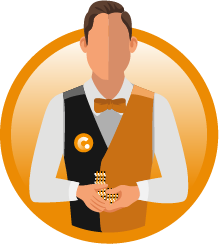
Did you know?
Did you know that what other players at the table do has no effect on your strategy? Basic blackjack strategy is purely about weighing up your own hand against the dealer’s and deciding whether to hit or stand on that basis. It doesn’t matter if someone else has 21 or makes an error.

Previous: Card Values
Next: Blackjack Variations

